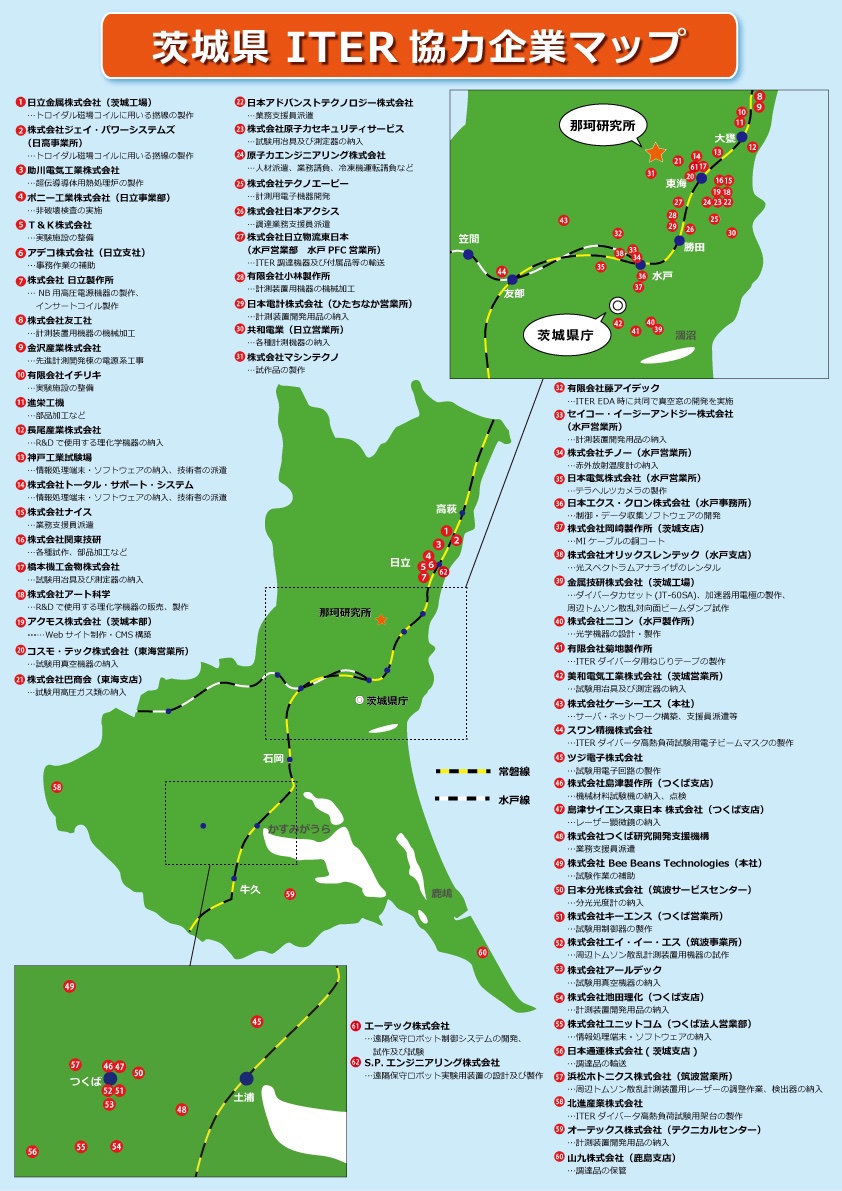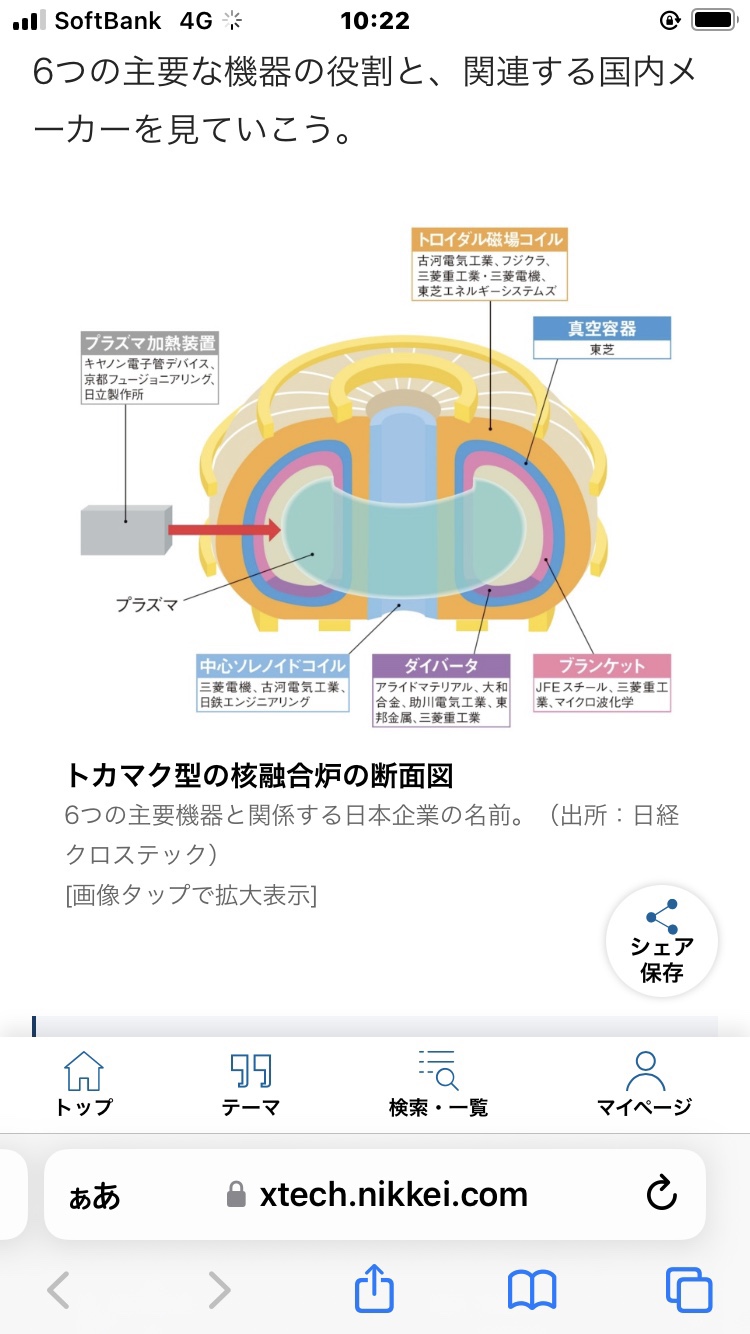

Japan’s Fusion Reactor: List of Japan’s ITER Industry!
-Map of Japan by 6 Major Device Manufacturers-
Fusion reactors of Japanese manufacturers:
At its core is a “nuclear fusion reactor that causes a nuclear fusion reaction.”
“Two atomic nuclei such as deuterium and tritium” are fused by hitting them in a plasma state.
“Take advantage of that energy.”
– Fusion Reactor Development by a Japanese Manufacturer –
Let’s take a look at the efforts of Japanese manufacturers while confirming the basics of nuclear fusion reactors.
“Tokamak-type” fusion reactor:
The explanation will focus on the nuclear fusion reactor of the method called “Tokamak type”.
The International Thermonuclear Experimental Reactor (ITER) in France and the Naka Institute of QST in Japan are scheduled to operate.
The world’s largest nuclear fusion experimental device “JT-60SA” is used.
“Helical” fusion reactor:
Like the tokamak type, the helical type “confines the plasma with a magnetic field”, but the shape of the coil is different.
“Laser method” fusion reactor:
There is also a laser method that irradiates the fuel with a powerful laser to cause a nuclear fusion reaction.
Cross-section of a tokamak-type fusion reactor:
The cross-section of a fusion reactor is shown in the figure below. Let’s take a look at the “roles of 6 main devices and related Japanese manufacturers” among the devices that make up the furnace. 1. Toroidal magnetic field (TF) coil:
Coil with superconducting wire wound around a toroidal (annular) core
“A strong magnetic field is created in the donut space by passing an electric current”, and the high-temperature plasma is confined by the magnetic field.
Plasma is not stable with only the TF coil.
Therefore, it is used together with a “poloidal magnetic field (PF) coil that pushes the plasma inward.”
Japanese manufacturers:
Furukawa Electric: High temperature superconducting wire
Furukawa Electric Co., Ltd. has received an order for high-temperature superconducting wire materials from British nuclear fusion startup Tokamak Energy.
Fujikura: High temperature superconducting wire
Fujikura received an order for high-temperature superconducting wires from Commonwealth Fusion, a nuclear fusion reactor operated by MIT in the United States.
ITER’s TF coil:
Mitsubishi Heavy Industries/Mitsubishi Electric and Toshiba Energy Systems (Kawasaki City) produced TF coils for I and TER.
2. Center Solenoid (CS) Coil:
-Superconducting coil installed in the cylindrical space at the center of the reactor-
In order to initiate a nuclear fusion reaction, hydrogen is heated to a plasma state.
“In other words, the nucleus and electrons must be separated.”
CS coils are:
This device is responsible for starting up the plasma.
When a current is passed through the coil, the current also flows through the plasma, heating the plasma.
Japanese manufacturers:
Mitsubishi Electric
Mitsubishi Electric made the CS coil for JT60-SA.
Furukawa Electric
Furukawa Electric manufactures superconducting wires for ITER.
Nippon Steel Engineering
Superconducting wires are twisted together and “welded with a metal tube into which a superconducting cable is inserted.”
For the process of drawing and winding superconducting cables into metal pipes,
Manufactures superconductors and conductors for ITER.
3. Plasma heating device
-The plasma temperature required for a nuclear fusion reactor is 100 million degrees Celsius or more-
Two types of heating devices are required to “heat to ultra-high temperatures and sustain the fusion reaction.”
One is the gyrotron:
A device that heats plasma with electromagnetic waves using the same principle as a microwave oven.
A specific name of the device is “gyrotron, which is an electron tube that oscillates at high frequencies.”
The other is the NBI heating device:
The plasma is heated by injecting high-energy neutral particles into it.
It is a neutral particle injection (NBI) heating device.
Japanese manufacturers:
canon electron tube device
Canon Electron Tube Devices worked on the gyrotron for ITER.
Kyoto Fusioneering
Startup Kyoto Fusioneering is also working on the development of the gyrotron.
Hitachi
Hitachi is building the NBI heating equipment for ITER.
Nikkei Cross Tech (xTECH)
https://xtech.nikkei.com/atcl/nxt/column/18/00001/07886/
Réacteur à fusion japonais : liste de l’industrie japonaise ITER !
-Carte du Japon par 6 principaux fabricants d’appareils-
Réacteurs à fusion des constructeurs japonais :
Au cœur se trouve un “réacteur de fusion nucléaire qui provoque une réaction de fusion nucléaire”.
“Deux noyaux atomiques tels que le deutérium et le tritium” sont fusionnés en les frappant à l’état de plasma.
“Profitez de cette énergie.”
– Développement d’un réacteur à fusion par un fabricant japonais –
Jetons un coup d’œil aux efforts des fabricants japonais tout en confirmant les bases des réacteurs à fusion nucléaire.
Réacteur à fusion « type Tokamak » :
L’explication portera sur le réacteur à fusion nucléaire de la méthode dite “de type Tokamak”.
Le réacteur thermonucléaire expérimental international (ITER) en France et l’Institut Naka de QST au Japon devraient être opérationnels.
Le plus grand dispositif expérimental de fusion nucléaire au monde “JT-60SA” est utilisé.
Réacteur de fusion « hélicoïdal » :
Comme le type tokamak, le type hélicoïdal “confine le plasma avec un champ magnétique”, mais la forme de la bobine est différente.
Réacteur de fusion « méthode laser » :
Il existe également une méthode laser qui irradie le combustible avec un laser puissant pour provoquer une réaction de fusion nucléaire.
Coupe transversale d’un réacteur à fusion de type tokamak :
La coupe transversale d’un réacteur à fusion est représentée sur la figure ci-dessous. Jetons un coup d’œil aux “rôles de 6 appareils principaux et des fabricants japonais associés” parmi les appareils qui composent le four. 1. Bobine de champ magnétique toroïdal (TF) :
Bobine avec fil supraconducteur enroulé autour d’un noyau toroïdal (annulaire)
“Un champ magnétique puissant est créé dans l’espace du beignet en faisant passer un courant électrique”, et le plasma à haute température est confiné par le champ magnétique.
Le plasma n’est pas stable avec seulement la bobine TF.
Par conséquent, il est utilisé avec une “bobine de champ magnétique poloidal (PF) qui pousse le plasma vers l’intérieur”.
Fabricants japonais :
Furukawa Electric : Fil supraconducteur haute température
Furukawa Electric Co., Ltd. a reçu une commande de matériaux de fil supraconducteur à haute température de la part de la start-up britannique de fusion nucléaire Tokamak Energy.
Fujikura : fil supraconducteur haute température
Fujikura a reçu une commande de fils supraconducteurs à haute température de Commonwealth Fusion, un réacteur à fusion nucléaire exploité par le MIT aux États-Unis.
Bobine TF d’ITER :
Mitsubishi Heavy Industries/Mitsubishi Electric et Toshiba Energy Systems (Kawasaki City) ont produit des bobines TF pour I et TER.
2. Bobine de solénoïde centrale (CS) :
-Bobine supraconductrice installée dans l’espace cylindrique au centre du réacteur-
Afin d’initier une réaction de fusion nucléaire, l’hydrogène est chauffé à l’état de plasma.
“En d’autres termes, le noyau et les électrons doivent être séparés.”
Les bobines CS sont :
Cet appareil est responsable du démarrage du plasma.
Lorsqu’un courant traverse la bobine, le courant traverse également le plasma, chauffant le plasma.
Fabricants japonais :
Mitsubishi électrique
Mitsubishi Electric a fabriqué la bobine CS pour JT60-SA.
Furukawa électrique
Furukawa Electric fabrique des fils supraconducteurs pour ITER.
Ingénierie de l’acier nippon
Les fils supraconducteurs sont torsadés ensemble et “soudés avec un tube métallique dans lequel un câble supraconducteur est inséré”.
Pour le processus de tréfilage et d’enroulement de câbles supraconducteurs dans des tuyaux métalliques,
Fabrique des supraconducteurs et des conducteurs pour ITER.
3. Dispositif de chauffage au plasma
-La température du plasma requise pour un réacteur à fusion nucléaire est de 100 millions de degrés Celsius ou plus-
Deux types de dispositifs de chauffage sont nécessaires pour “chauffer à des températures ultra-élevées et entretenir la réaction de fusion”.
L’un est le gyrotron :
Un appareil qui chauffe le plasma avec des ondes électromagnétiques utilisant le même principe qu’un four à micro-ondes.
Un nom spécifique de l’appareil est “gyrotron, qui est un tube électronique qui oscille à haute fréquence”.
L’autre est le dispositif de chauffage NBI :
Le plasma est chauffé en y injectant des particules neutres à haute énergie.
Il s’agit d’un appareil de chauffage à injection de particules neutres (NBI).
Fabricants japonais :
appareil à tube électronique canon
Canon Electron Tube Devices a travaillé sur le gyrotron pour ITER.
Kyoto Fusioneering
La startup Kyoto Fusioneering travaille également au développement du gyrotron.
Hitachi
Hitachi construit l’équipement de chauffage NBI pour ITER.
Nikkei CrossTech (xTECH)
Japans Fusionsreaktor: Liste der japanischen ITER-Industrie!
-Karte von Japan von 6 großen Geräteherstellern-
Fusionsreaktoren japanischer Hersteller:
Sein Kern ist ein „Kernfusionsreaktor, der eine Kernfusionsreaktion auslöst“.
“Zwei Atomkerne wie Deuterium und Tritium” werden verschmolzen, indem man sie in einem Plasmazustand trifft.
„Nutzen Sie diese Energie.“
– Fusionsreaktorentwicklung eines japanischen Herstellers –
Werfen wir einen Blick auf die Bemühungen japanischer Hersteller, während wir die Grundlagen von Kernfusionsreaktoren bestätigen.
Fusionsreaktor vom „Tokamak-Typ“:
Die Erklärung konzentriert sich auf den Kernfusionsreaktor des als “Tokamak-Typ” bezeichneten Verfahrens.
Der International Thermonuclear Experimental Reactor (ITER) in Frankreich und das Naka Institute of QST in Japan sollen in Betrieb gehen.
Zum Einsatz kommt das weltweit größte Kernfusions-Experimentalgerät „JT-60SA“.
„Helix“-Fusionsreaktor:
Wie der Tokamak-Typ “schließt der spiralförmige Typ das Plasma mit einem Magnetfeld ein”, aber die Form der Spule ist anders.
Fusionsreaktor „Laserverfahren“:
Es gibt auch ein Laserverfahren, bei dem der Brennstoff mit einem starken Laser bestrahlt wird, um eine Kernfusionsreaktion auszulösen.
Querschnitt eines Fusionsreaktors vom Tokamak-Typ:
Der Querschnitt eines Fusionsreaktors ist in der folgenden Abbildung dargestellt. Werfen wir einen Blick auf die “Rollen von 6 Hauptgeräten und verwandten japanischen Herstellern” unter den Geräten, aus denen der Ofen besteht. 1. Toroidale Magnetfeldspule (TF):
Spule mit supraleitendem Draht, der um einen Ringkern gewickelt ist
“Durch das Hindurchleiten eines elektrischen Stroms wird im Donut-Raum ein starkes Magnetfeld erzeugt”, und das Hochtemperaturplasma wird durch das Magnetfeld eingeschlossen.
Plasma ist nicht stabil nur mit der TF-Spule.
Daher wird es zusammen mit einer “poloidalen Magnetfeldspule (PF) verwendet, die das Plasma nach innen drückt”.
Japanische Hersteller:
Furukawa Electric: Supraleitender Hochtemperaturdraht
Furukawa Electric Co., Ltd. hat vom britischen Kernfusions-Startup Tokamak Energy einen Auftrag für hochtemperatursupraleitende Drahtmaterialien erhalten.
Fujikura: Hochtemperatur-Supraleiterdraht
Fujikura erhielt einen Auftrag für Hochtemperatur-Supraleiterdrähte von Commonwealth Fusion, einem vom MIT in den Vereinigten Staaten betriebenen Kernfusionsreaktor.
TF-Spule von ITER:
Mitsubishi Heavy Industries/Mitsubishi Electric und Toshiba Energy Systems (Kawasaki City) produzierten TF-Spulen für I und TER.
2. Mittlere Magnetspule (CS):
-Supraleitende Spule, installiert im zylindrischen Raum in der Mitte des Reaktors-
Um eine Kernfusionsreaktion auszulösen, wird Wasserstoff in einen Plasmazustand erhitzt.
“Mit anderen Worten, Kern und Elektronen müssen getrennt werden.”
CS-Spulen sind:
Dieses Gerät ist für das Hochfahren des Plasmas verantwortlich.
Wenn ein Strom durch die Spule geleitet wird, fließt der Strom auch durch das Plasma und erwärmt das Plasma.
Japanische Hersteller:
Mitsubishi Electric
Mitsubishi Electric hat die CS-Spule für JT60-SA hergestellt.
Furukawa elektrisch
Furukawa Electric fertigt supraleitende Drähte für ITER.
Nippon Steel Engineering
Supraleitende Drähte werden miteinander verdrillt und “mit einem Metallrohr verschweißt, in das ein supraleitendes Kabel eingeführt wird”.
Für den Prozess des Ziehens und Wickelns von supraleitenden Kabeln in Metallrohre,
Stellt Supraleiter und Leiter für ITER her.
3. Plasmaheizgerät
-Die für einen Kernfusionsreaktor erforderliche Plasmatemperatur beträgt 100 Millionen Grad Celsius oder mehr-
Zwei Arten von Heizgeräten sind erforderlich, um “auf ultrahohe Temperaturen zu erhitzen und die Fusionsreaktion aufrechtzuerhalten”.
Eines ist das Gyrotron:
Ein Gerät, das Plasma mit elektromagnetischen Wellen nach dem gleichen Prinzip wie ein Mikrowellenherd erhitzt.
Ein spezifischer Name des Geräts ist “Gyrotron, eine Elektronenröhre, die mit hohen Frequenzen oszilliert”.
Das andere ist das NBI-Heizgerät:
Das Plasma wird erhitzt, indem hochenergetische neutrale Teilchen hinein injiziert werden.
Es ist ein Heizgerät mit neutraler Partikelinjektion (NBI).
Japanische Hersteller:
Canon Elektronenröhrengerät
Canon Electron Tube Devices arbeitete am Gyrotron für ITER.
Kyoto Fusioneering
Auch das Startup Kyoto Fusioneering arbeitet an der Entwicklung des Gyrotrons.
Hitachi
Hitachi baut die NBI-Heizausrüstung für ITER.
Nikkei Cross Tech (xTECH)